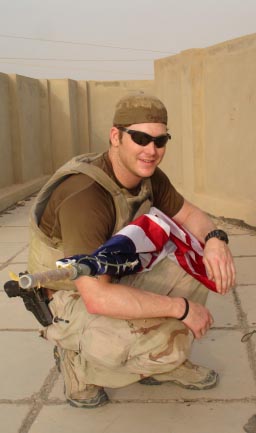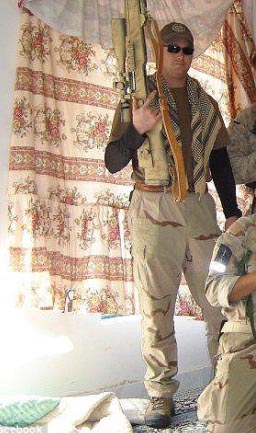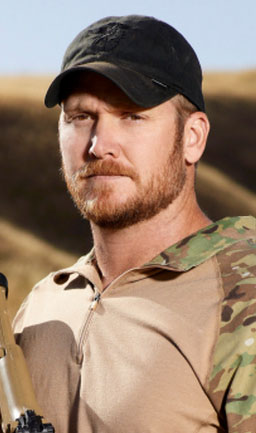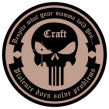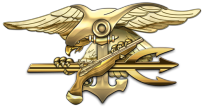There are several steps you need to complete to get to the SEALS. One is the Navy’s basic training programme which Chris completed easily. The next is BUDS which is very difficult and is a way for the Navy to weed out the weaker recruits and find those that might have a chance at the SEAL teams.
BUDS was very hard for Chris and he only just made it to the end. He wrote in his book American Sniper that at one stage he wanted to ring the bell so he could go home but couldn't have been bothered walking all the way to the bell to ring it, so he stuck with it. At this stage he was lying in freezing cold water with his arms linked with the other recruits and was told if he quit he would get a hot coffee and a doughnut. But he kept at it and passed BUDS successfully. He did receive an injury in BUDS which delayed his graduation. After this of course was SEAL training.
Assigned to SEAL Team 3, Sniper Element Charlie platoon within the Naval Special Warfare Command, and with over four tours of duty, Kyle served in many major battles of the Iraq War (Operation Iraqi Freedom) and elsewhere. He was on the ground for the initial invasion in 2003. He was in Fallujah in 2004. He went back, to Ramadi in 2006, and then again, to Baghdad in 2008, where he was called in to secure the Green Zone by going into Sadr City.
As he would eventually describe in American Sniper, his first kill
on the sniper rifle came in late March 2003, in Nasiriya, Iraq. It
wasn’t long after the initial invasion, and his platoon—“Charlie” of
SEAL Team 3—had taken a building earlier that day so they could
provide overwatch for a unit of Marines thundering down the road. He
was holding a bolt-action .300 Winchester Magnum that belonged to
his platoon chief. He saw a woman about 50 yards away. As the
Marines got closer, the woman pulled a grenade. Hollywood might have
you believe that snipers aim for the head—“one shot, one kill”—but
effective snipers aim for the middle of the chest, for center mass.
Kyle pulled the trigger twice.
His extensive combat experience includes sniping, close-quarters
battle, reconnaissance, long-range desert patrols, personal security
and the training for foreign allies. In addition to working and
training with the elite Navy SEALs, Chief Kyle has also served with
units from the Army, Marine Corps and other government agencies.
For his bravery in battle, he was awarded two Silver Stars, five
Bronze Stars with Valor, two Navy and Marine Corp Achievement
Medals, and one Navy and Marine Corps commendation. Following his
combat deployments, he became chief instructor for training Naval
Special Warfare Sniper and Counter-Sniper teams, and he authored the
Naval Special Warfare Sniper Doctrine, the first Navy SEAL sniper
manual.
For his deadly track record as a marksman during his deployment
to Ramadi, the insurgents named him Shaitan Ar-Ramadi (English: The
Devil of Ramadi), and put a $20,000 bounty on his head that was
later increased to $80,000. He joked that he was afraid to go home
at one point. “I was worried my wife might turn me in,” he said.
Most of his platoon was in the Pacific theater before the 2004
deployment. Kyle was sent early to assist Marines clearing
insurgents in Fallujah. Tales of his success in combat trickled back
to his team. He was originally supposed to watch over the American
forces perched at a safe distance, but he thought he could provide
more protection if he was on the street, going house to house with
his boys. During one firefight, it was reported that Kyle ran
through a hail of bullets to pull a wounded Marine to safety. His
teammates, hearing these stories, started sarcastically referring to
him as The Legend.
Those stories of bravery in battle proliferated on his third
deployment. A younger SEAL was with Kyle at the top of a building in
Ramadi when they came under heavy fire. The younger SEAL, who is
still active in the teams and can’t be named, dropped to the ground
and hid behind an interior wall. When he finally looked up, he saw
Kyle standing there, glued to his weapon, covering his field of
fire, calling out enemy positions as he engaged.
Kyle said the combat was the worst on his last deployment, to Sadr
City in 2008. The enemy was better armed than before. Now it seemed
like every time there was an attack, there were rocket-propelled
grenades and fights that went on for days. This was also the
deployment that produced Kyle’s longest confirmed kill.
He was on the second floor of a house on the edge of a village. With
the scope of his .338 Lapua, he started scanning out farther into
the distance, to the edge of the next village, a mile away. He saw a
figure on the roof of a one-story building. The figure didn’t seem
to be doing much, and at the moment he didn’t appear to have a
weapon. But later that day, as an Army convoy approached, Kyle
checked again and saw the man holding what looked like an RPG. At
that distance, Kyle could only estimate his calculations.
He pulled the trigger and watched through his scope as the Iraqi,
2,100 yards away, fell off the roof. It was the world’s
eighth-longest confirmed kill shot by a sniper. Later, Kyle called
it a “really, really lucky shot.” During four tours of duty in Iraq,
Kyle was shot twice and caught up in six separate IED explosions.
His other weapons included the Mk 12 sniper rifle, M4 carbine and a
.300 Winchester Magnum sniper rifle.
Hardest decision Chris ever made was to leave the SEALS.
He says in his book:
“I left knowing the guy who replaced me dies or
messes up and other people die, that’s on me. You really feel
like you’re letting down these guys you’ve gone through hell with.”
For Chris it was all about his mates. He said “The hardest part for
me is not being with the team and not being around them in the
action. That was my life and I lived it every day for years.
Jesse Ventura
Jesse Ventura was a former Navy Demolition team member who served in Vietnam, but it is not known if he ever saw combat. After leaving the military, he tried various things including acting where he starred in some of Arnold Schwarzenegger movies including Predator. This is a picture from that movie with Ventura on the left.

Chris was at a wake for fallen SEAL Michael Monsoor, who was
posthumously awarded the Medal of Honour for throwing himself on a
grenade to save the lives of fellow SEALs. This was when Chris met
Ventura.
The lads were in one of their SEAL bars in Coronado, California. Ventura was
also at the bar and according to Chris and some other SEALS, Ventura
began to disrespect the troops says they were child killers an the
like. Chris asked him to stop with the abuse but then Ventura said, “You
guys deserve to lose a few.” That was when Chris punched and knocked
down Ventura. He immediately left the bar as the police were sure to
arrive. Shoot and skoot. Ventura has denied the event happened and filed a
lawsuit against Chris Kyle for defemation of character. But two other former SEALs, friends of Kyle’s,
said they were there that night, and it happened just the way
Kyle said it did. Since Chris Kyles death, Ventura decided to turn
his attention to his wife and is now suing her.
He won the law suit in early 2015 and was awarded 1.8 million dollars, Ventura says the law suit was never about the money, but about clearing his name, He also said that he did not think that Chris Kyle was a war hero. He said "men with honour are war heroes and Chris Kyle has no honor".

